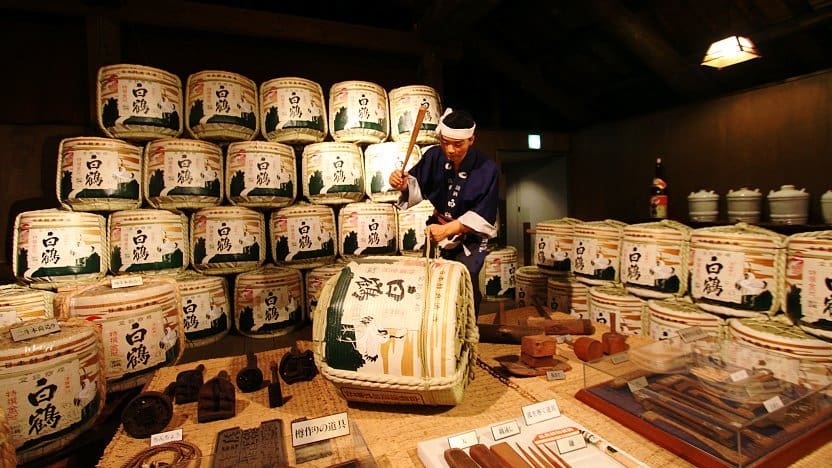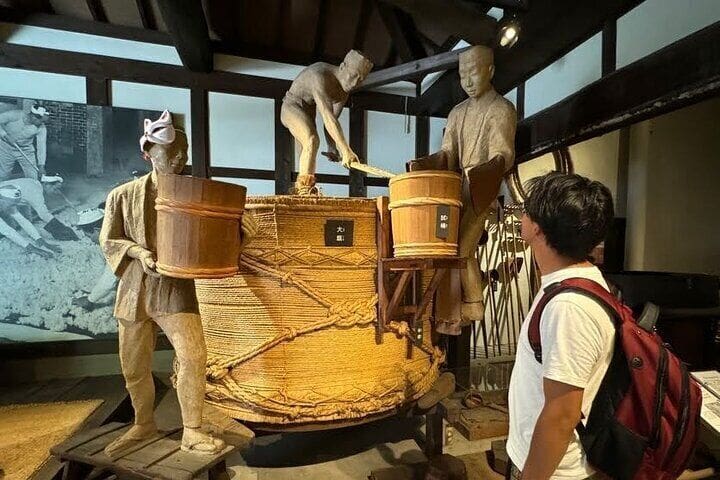Kobe known worldwide for its luxurious beef and scenic port views is also home to one of Japan’s most important sake-producing regions. Nestled along the slopes of Mt. Rokko and kissed by mineral-rich waters, the city’s Nada district produces about 30% of all sake in Japan. But tasting Kobe sake is just the beginning. If you’re looking for a rich cultural experience that combines history, craftsmanship, and flavor, a sake brewery visit in Kobe is the perfect way to immerse yourself in Japanese tradition, one sip at a time.
In this guide, we’ll walk you through everything you need to know to enjoy a full day exploring Kobe’s sake breweries from choosing the right spot to visiting museums, sipping sake like a pro, and discovering the beauty beyond the bottle.
Why Visit a Kobe Sake Brewery?
Kobe’s sake isn’t just another drink it’s an art form cultivated over centuries. With ideal natural conditions (soft water from Mt. Rokko, cool temperatures, and quality rice), the city has become a hub for high-grade sake brewing.
But visiting a sake brewery is about much more than alcohol. It’s an opportunity to:
- Witness generations-old brewing techniques in action
- Learn how rice transforms into liquid gold through complex fermentation
- Taste exclusive, freshly brewed varieties not available anywhere else
- Meet the artisans and brewers keeping tradition alive
- Soak in beautiful kura (storehouses) lined with cedar barrels and stone walls
Whether you’re a sake novice or a seasoned enthusiast, a day spent in one of Kobe’s iconic breweries gives you access to Japan’s soul through craftsmanship, community, and culture.
Choosing the Right Sake Brewery in Kobe
Kobe’s Nada district alone is home to dozens of breweries some large and tourist-ready, others quaint and traditional. Here are a few standout options, each offering its own unique flavor of hospitality and history.
1. Hakutsuru be Brewery Museum

Located in the heart of Nada, this brewery offers a hands-on introduction to the sake-making process through an immersive museum experience. Housed inside a restored 100-year-old warehouse, you’ll walk past dioramas, wooden vats, and tools once used by master brewers. Free tastings await you at the end.
Don’t miss: Hakutsuru’s unpasteurized “Nama” sake fresh, bold, and full of life.

2. Kiku-Masamune Sake Brewery
For those interested in the science of sake, Kiku-Masamune provides a blend of history and precision. The museum showcases century-old brewing equipment and a beautifully preserved copper still. Their guided tours (available in English) include tasting flights of dry-style sakes, which pair exceptionally well with grilled seafood.
Try: Their crisp taru sake, aged in cedar barrels.

3. Kenbishi Sake Brewery
A hidden gem with centuries of prestige, Kenbishi prides itself on minimal intervention and deeply rich flavors. It’s a smaller, quieter brewery that gives visitors an intimate look at artisanal brewing without the crowds.
Highlight: Aged sake tastings that introduce earthy, savory complexity.

4. Fukunishiki Sake Brewery
This brewery leans into community and sustainability, offering workshops where you can try polishing rice or creating your own sake blend. The staff here are eager to explain the “why” behind each process, and you’ll leave with a deeper appreciation of the craft.
Best for: Visitors seeking a hands-on experience.

Planning Your Perfect Sake Day in Kobe
Book in Advance
While walk-ins are welcome at many breweries, tours especially in English often require reservations. Plan ahead to ensure you get a slot, especially during peak seasons like spring (March–April) and fall (October–November).
Dress and Prepare Smart
- Breweries can be chilly year-round, especially in fermentation rooms. Wear layers.
- Bring a small bag for souvenirs or sake bottles (many shops offer eco bags too).
- A notebook helps if you want to jot down tasting notes or fun facts from guides.
When to Visit
Each season has its own charm:
- Winter: Peak brewing season. Great time to see live fermentation in action.
- Spring: Release of “shiboritate” (freshly pressed) sake.
- Autumn: Cooler weather and vibrant foliage make for scenic walking between kura.
A Step-by-Step Sake Brewery Itinerary in Kobe
Here’s how to stretch your single-day visit into a satisfying cultural journey:
Morning: Start at Nada Sake District
Arrive by train (Nada or Ishiyagawa Station are convenient) and begin your stroll through Japan’s most famous sake-making neighborhood.
Tip: Stop by a local kissaten (retro café) or grab green tea to start your day fresh.
Wander past classic white-walled warehouses with tiled roofs and large cedar balls (sugidama) hanging above the entrances signifying that a new batch of sake is ready.
Mid-Morning: Brewery Tour & Museum
Join a guided tour at Hakutsuru or Kiku-Masamune. You’ll learn how rice is milled to perfection, soaked, and transformed by koji mold into a bubbling mash. Watch videos, touch tools, and even peek into fermentation vats. If you’re lucky, you might witness seasonal sake pressing in action.
What you’ll learn:
- The difference between junmai, ginjo, and daiginjo
- How the brewing team uses temperature control to manage fermentation
- The role of toji (master brewers) in flavor development
Lunch: Pairing Sake with Local Flavors
After all that learning, it’s time to eat.
Many breweries have in-house cafés serving food designed to complement their sake. Think:
- Grilled fish with dry junmai
- Soba noodles with crisp daiginjo
- Donburi rice bowls with savory koshu (aged sake)
Alternatively, head to a local izakaya where you can sample small plates like yakitori, tofu dengaku, or pickled vegetables,each made to enhance sake’s flavor profiles.
Early Afternoon: Tasting & Sensory Exploration
Now comes the highlight , tasting.
Most breweries offer a free or modestly priced flight of sake samples. You’ll usually try:
- Junmai (pure rice sake, earthy and bold)
- Ginjo (light, floral, mildly sweet)
- Daiginjo (elegant and smooth, with fruity aromatics)
- Nigori (cloudy, creamy, semi-sweet)
- Koshu (aged, amber-toned with deep umami)
Pro Tip: Start from light to strong. Use water or rice crackers to cleanse your palate.
Want to go deeper? Sign up for a tasting workshop or sake-sommelier experience where you’ll learn about aroma notes, food pairings, and how to judge sake quality.
Late Afternoon: Souvenirs and Scenic Walks
Head into the brewery shop or nearby specialty stores. This is the best time to pick up:
- Limited-edition sake (many only sold at the brewery)
- 300ml bottles (perfect for travel)
- Wooden masu cups, engraved ochoko (tasting cups)
- Rice crackers or sake-pairing snacks
Stroll along the Rokko foothills or visit a nearby Shinto shrine many are nestled quietly beside kura buildings and add an extra touch of serenity to your sake-filled day.
Evening: Dinner & Nightcap
Wrap up your day with a relaxing dinner in Kobe City. Choose a restaurant that offers sake pairing menus you’ll now be able to recognize the types and even recommend a bottle!
Suggested dishes:
- Tempura with dry ginjo
- Grilled Kobe beef and aged koshu
- Hotpot (nabe) with umami-forward junmai
Compare what you tried during the day to the restaurant’s offerings. It’s a delicious way to reinforce what you’ve learned and a perfect toast to a day well spent.
Sake Tasting Tips from Locals
- Sip, Don’t Gulp
Good sake reveals its character slowly let it sit on your tongue and breathe in the aroma. - Room Temp or Chilled?
Chilled daiginjo highlights fruity notes, while room-temp junmai brings out full-bodied umami. - Look for Unpasteurized Varieties
“Nama” sake is bold and often only available seasonally. Ask the staff for recommendations. - Snack Between Sips
Neutral foods like daikon or senbei (rice crackers) help reset your palate. - Don’t Be Afraid to Ask
Brewery staff love talking about their sake. Whether you’re curious about water sources or ideal food matches, just ask.
What to Bring Home from a Kobe Sake Brewery
Beyond the bottles, there are plenty of keepsakes that let you savor the experience long after your visit ends:
- Junmai Daiginjo Bottles: Elegant and often beautifully packaged
- Koshu (Aged Sake): Robust and unique great for gifting
- Nama Genshu: Undiluted, full-strength, and only found at breweries
- Wooden Sake Cups: Fragrant cedar enhances sake aroma
- Sake Tasting Sets: Great for hosting your own mini tasting at home
- Sake-Paired Snacks: Dried fish, yuba chips, miso nuts—all designed to match flavors
Add-On Experiences to Extend Your Day
If time allows, enhance your day with these memorable additions:
- Sake-Pairing Dinners: Book a multi-course dinner featuring sake from your chosen brewery
- Cocktail Class: Learn how to mix sake with yuzu, plum wine, or gin
- Stay Overnight: Ryokans in Nada or central Kobe often serve locally brewed sake as part of the experience
- Sake Festivals: Time your trip around spring or autumn festivals that showcase dozens of breweries under one roof
Why Kobe Sake Breweries Are Worth the Journey
Visiting a Kobe sake brewery is more than an outing it’s a window into Japan’s heritage.
Here, everything is done with intention. The water is drawn from ancient wells. The rice is polished with care. The brewers rise early and work quietly, hands steeped in centuries of tradition. And when you finally lift that ochoko to your lips, you’re tasting not just sake but the story behind it.
From first fermentation to your final sip, a day spent in Kobe’s sake world is a memory wrapped in aroma, texture, and the warmth of shared discovery.
FAQs – Visiting a Sake Brewery in Kobe
1. Do I need to be a sake expert?
Not at all. Tours and tastings are designed for beginners. Just come curious.
2. Can I drive to the brewery if I’m tasting?
It’s best not to. Use the train or a taxi driving after alcohol isn’t allowed.
3. Are English tours available?
Yes, most major breweries like Hakutsuru offer English tours. Smaller places might use printed guides or basic English support.
4. What’s the best time of year to visit?
Winter and early spring are prime fermentation is active and fresh sake is released.
5. Is sake a good gift?
Absolutely. Go for seasonal or brewery-exclusive bottles in decorative boxes.
Final Thoughts: Raise Your Glass to Kobe
From ancient brewing wisdom to tasting rooms filled with laughter and discovery, Kobe’s sake culture offers an experience that stays with you long after your visit. It’s in the conversations with brewers, the cedar-scented storehouses, the first sip of unfiltered sake under a spring sky.
So whether you’re a foodie, a traveler, or just someone curious about Japan beyond the usual sights, give yourself the gift of a day among the brewers of Kobe. It may just be the most memorable glass you’ll ever raise.
Join Us and book your tour now!
My another travel booking site is https://www.cityunscripted.com/ you can check the reviews here!
